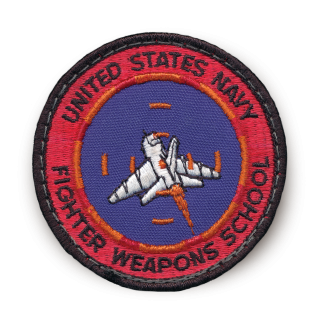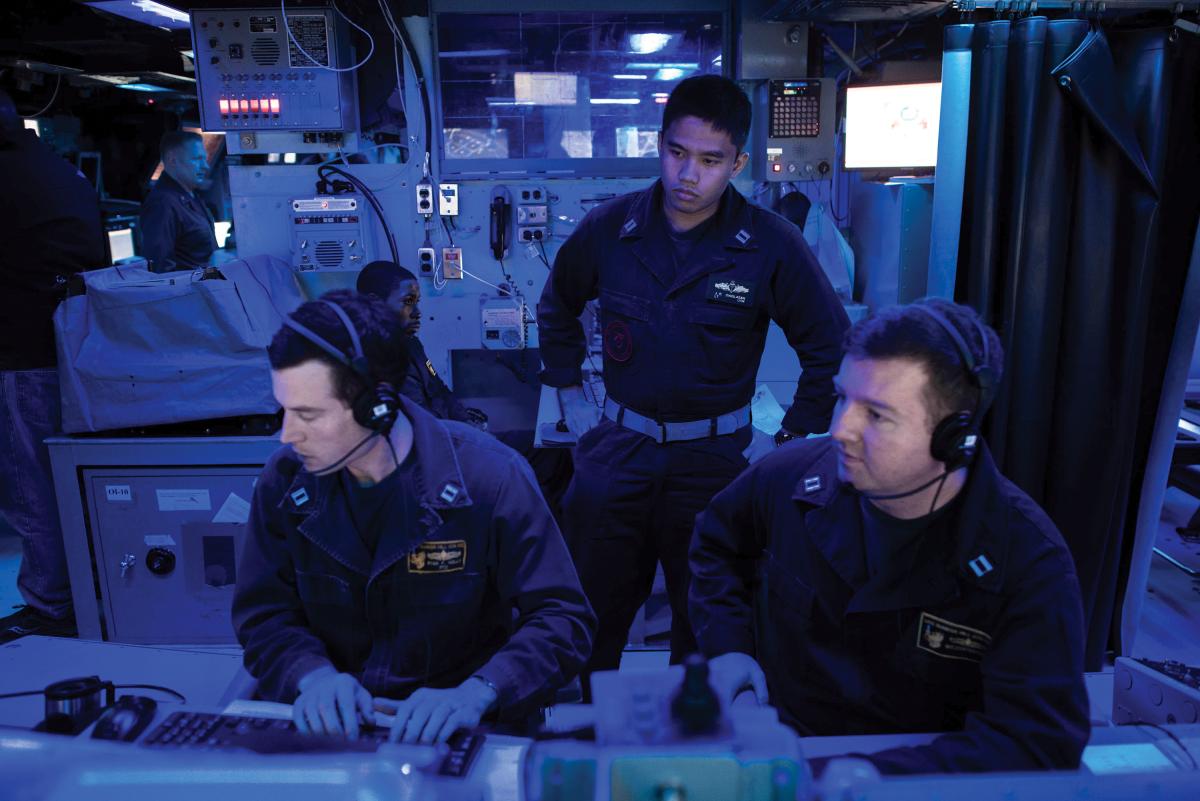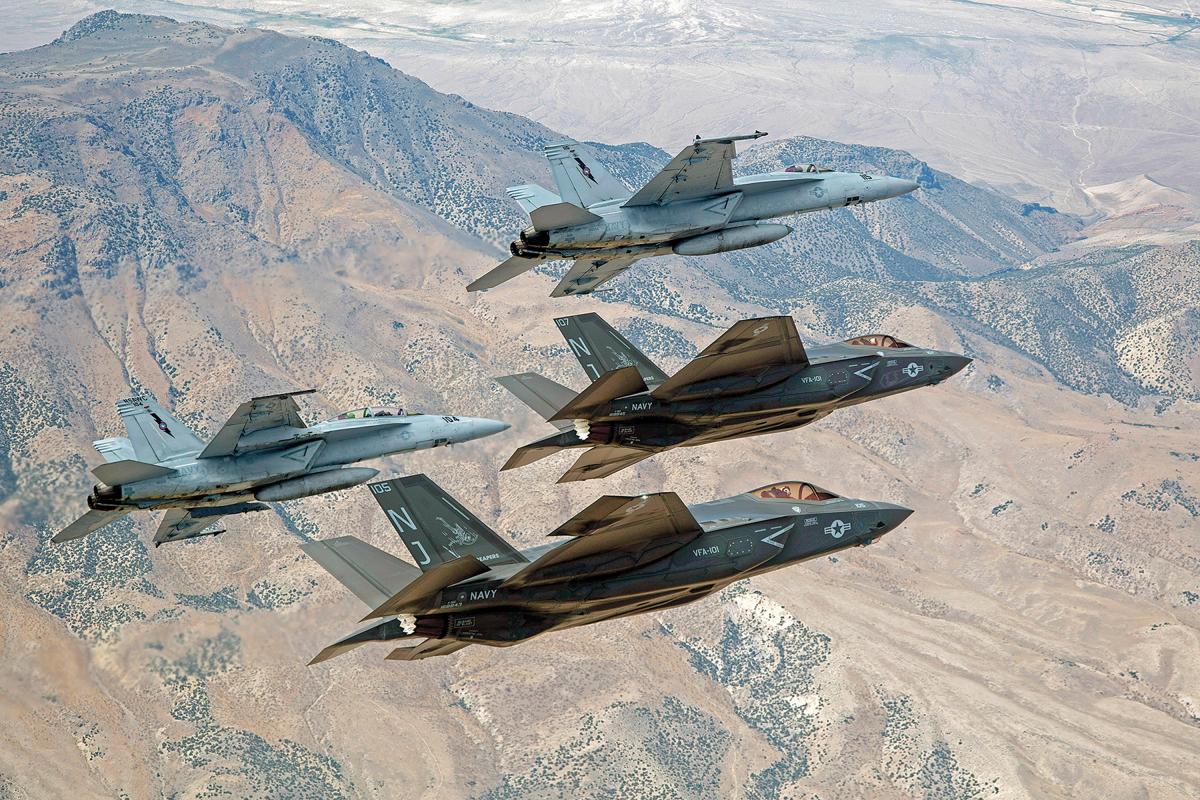TOPGUN’s initial impact on fleet tactics and air-to-air performance was remarkable. The school took aircrew with little training in dogfighting and turned them into aggressive aviators thoroughly versed in air combat maneuvers, capable of fighting an aircraft to its limits. Aircrew were taught to appreciate not only their own aircraft and its weapon systems, but those of their adversaries. But this instruction, although more advanced than anything the crews were getting in the fleet, was still not at a level crews needed to be as tactically proficient as their adversaries required. “The crews were just not ready to absorb it all at that point,” said one instructor of that era.
Early tactics were designed to be more defensive in nature and were based on drag tactics, in which the engaged fighter would pull the MiG away from the fight, opening up an opportunity for the engaged fighter’s wingman to shoot the MiG. TOPGUN asked, “What if the engaged fighter has an advantage or can get an advantage early in the fight?” If so, “You don’t need to default immediately to the drag tactic. You might just be able to go in and kill the guy outright,” said Dave Frost, a member of TOPGUN’s staff in 1971 and later commanding officer of the school. Thus, by late 1971 TOPGUN refocused tactics to be more offensively minded and pushed that information to the fleet, which helped in many of the 1972 engagements.
Efforts to raise the bar continued into the 1970s, as TOPGUN incorporated lessons from the 1974–1978 Air Combat Evaluation/Air Intercept Missile Evaluation Study into its all-aspect missile tactics, adjusted to the forward-quarter threat posed by the Soviet MiG-23 Flogger (the first Soviet fighter to possess look-down/shoot-down radar and a beyond-visual-range missile). The school revised tactics yet again in the 1980s to counter the Soviet MiG-29 Fulcrum and Su-27 Flanker 4th generation fighters. More recently, TOPGUN revamped fighter tactics in the mid-2000s as a result of evolving foreign threats, and it continues to revisit those tactics today. Each of these moments highlights TOPGUN’s continuous efforts to stay ahead of adversaries.
Air Intercept Controller (AIC) Training
The benefits of effective air intercept control were demonstrated during the latter stages of the Vietnam War. The Navy adopted a “positive identification radar advisory zone” (PIRAZ) in the Tonkin Gulf (radio callsign Red Crown) in 1971–1972. Under PIRAZ control, fighter aircrew had much greater situational awareness. The most famous controller was OSCM Larry “Ace” Nowell on board the USS Chicago (CG-11).
In late 1972, TOPGUN opened its fighter course to air intercept officers (AICs). At first, AICs attended lectures and provided intercept control for TOPGUN students during training missions and graduation exercises. These interactions improved both communities’ understanding of each other’s roles and led to better communication during intercepts in combat. As the program became more successful, AICs were added to the staff to develop lectures for aircrew and controllers, a practice that continues today with TOPGUN instructors from the surface warfare, E-2 Hawkeye, and Marine Corps communities.
Standardization of Adversary Training
The benefits of dissimilar air combat training (DACT) had been known since the mid-1960s, when F-8 Crusaders and F-4 Phantoms sparred in the skies over Southern California. But TOPGUN brought DACT into standard practice, making it the core of its training curriculum. TOPGUN further offered DACT flights to fleet squadrons preparing for overseas deployments. As demand for this training skyrocketed, TOPGUN’s capacity to support it was quickly superceded, leading to the creation of dedicated adversary squadrons. Soon it became apparent that these squadrons needed standardized training of their own.
In 1975, TOPGUN implemented an adversary instructor training course that ran for two weeks in between the regular fighter courses. Instructors were taught the basics of air combat maneuvering (ACM), instructional techniques, and how to replicate the capabilities and tactics of various adversaries. This program proved hugely successful and was eventually incorporated into the standard power projection course that adversary instructors and fleet aircrew both attended. Adversary instruction was again consolidated in the mid-1980s, when TOPGUN became the “model manager” for the fleet adversary program. New aircraft were acquired to better reflect the growing Soviet threat. Adversary squadrons assisted in the fleet fighter air combat readiness program (FFARP), and later the strike-fighter advanced readiness program (SFARP), providing muchneeded fleet support and freeing the TOPGUN staff to focus on its courses.
The Soviet Bomber Threat
TOPGUN was founded to improve air-to-air fighter performance, but introduction of the F-14 Tomcat brought another mission: maritime air superiority (MAS). In 1976, TOPGUN created TOPSCOPE, which sought to do for maritime air superiority what the fighter course had done for power projection—teach training officers advanced tactics to counter the Soviet bomber threat.
Focused on radar intercept officers, TOPSCOPE emphasized tactics to overcome heavy electronic jamming so fighters could engage threats at long range to “kill the archer before he launched his arrow.” TOPSCOPE’s core teachings were eventually woven into the F-14 replacement air group training syllabus and merged into the overall power projection course in 1980. The following year, a traveling fleet air superiority training (FAST) program commenced, which brought MAS lectures and simulator training to F-14 and E-2 Hawkeye squadrons as they prepared for deployment. TOPSCOPE and FAST developed “vector logic” and “chainsaw” tactics to counter the Soviet threat and maximize the Tomcat’s fleet-defense capabilities, specifically its AWG-9 radar and AIM-54 Phoenix missile.
Spreading the Word
By the early 1980s, TOPGUN realized that the fleet’s training needs had grown considerably since the school’s founding and that more needed to be done to disseminate tactical information to the fleet than could be accomplished by its graduates alone. Only a limited number of TOPGUN grads returned to the fleet (approximately 48 aircrew) each year, and not all squadrons fully utilized them as training officers. Lack of standardization resulted in widely disparate tactical knowledge within individual units. To remedy this, TOPGUN began working with carrier air wings at NAS Fallon, both at the newly formed Strike University and through FFARP training during work-ups. In addition, it developed an overland air superiority training program and a senior officer refresher course, and it increased its work with the medium attack (A-6 Intruder) and light attack (A-7 Corsair II) aviation communities. These outreach efforts expanded TOPGUN’s voice and impact on fleet readiness.
SFWT/SFTI
Perhaps the most significant improvement of all came in 1995 when TOPGUN switched from its original training model to the strike fighter weapons and tactics (SFWT) and strike fighter tactics instructor (SFTI) programs. When founded, TOPGUN accepted aircrew from each squadron at their mid-tour point, put them through the course, and upon graduation returned them to their fleet squadrons to serve as training officers. Students who showed promise as instructors were placed on a “wish list,” and at the conclusion of their first squadron tour might be asked to join the staff as an instructor.
Under the present SFTI construct, students instead attend TOPGUN at the conclusion of their first squadron tour, and upon successful completion they either stay on the TOPGUN staff or are assigned to a tour at Strike (the N5 department at the Naval Aviation Warfighting Development Center, responsible for air wing training), to the East or West Coast weapons schools, Air Test and Evaluation Squadron Nine (VX-9), or one of the fleet replacement squadrons.
TOPGUN graduates must complete their three-year follow-on assignments before returning to the fleet to serve two-year tours as squadron training officers overseeing compliance with the air combat training continuum. In fleet squadrons, TOPGUN graduates teach standardized tactics and guarantee qualification standardization. The SFTI program has resolved the problem of varying tactical performance among squadrons and air wings. Standardization now has reached the point where aircrew are interchangeable among squadrons—something that could not be said before 1995.
Impact on Other Communities
TOPGUN’s success as a school and its revolutionary methods for process improvement have had a ripple effect on other communities, both inside and outside naval aviation. Following the disastrous December 1983 naval air strikes on Syria, the Navy created Strike University (Strike U), which served as a graduate school for carrier air wings. TOPGUN served as the institutional model for Strike U and assisted in developing its curriculum and training its initial instructor cadre.
Today, every aviation platform in the Navy has its own weapons school—most falling under the Naval Aviation Warfighting Development Center—to develop standardized tactics and create expert training officers. Permeating this concept into other warfare communities, the Navy established the Surface and Mine Warfighting Development Center, the Undersea Warfighting Development Center, the Navy Expeditionary Warfighting Development Center, and Naval Information Warfighting Development Center to create WTIs in each community.
TOPGUN Today & Tomorrow
Today TOPGUN faces a challenge as monumental as the one it faced 50 years ago. While naval aviation has been focused mainly on operations in the Middle East and Afghanistan for the past three decades, Russia and China have increased their combat capabilities quickly and significantly. For the first time since the Cold War, the Navy faces adversaries that are technological equals (or very close).
To respond to this challenge, TOPGUN will leverage all of its organizational experience in tactics development, instructional techniques, and knowledge of air warfare while focusing on three main areas: increasing Navy fighter combat systems capabilities, developing advanced air-to-air and air-to-surface tactics, and building a training continuum that elevates the level of talent and proficiency in the fleet to win a high-end fight.
With a uniquely deep understanding of Navy fighter tactics and capabilities, as well as adversary tactics and capabilities, TOPGUN’s subject-matter experts will work closely with industry partners, Commander, Naval Air Forces, and the Navy (OpNav) staff to ensure the right combat capabilities are funded and developed. Responsibility for tactics development falls squarely on TOPGUN, so its inputs on tactical gaps and how best to close them will be critical.
Tactics development and combat systems capabilities go hand-in-hand. The greater the comparative advantage in combat systems capabilities, the less complex fighter tactics need to be, and, as a result, the more effective average fighter aircrew will be. The Navy’s current combat systems are relatively equal to those of our peer adversaries, so fighter tactics have become more complex to ensure they remain effective. This has reached a point where there is growing concern within TOPGUN that fighter aircrew are being asked to do too much. As new capabilities, including the F-35 B and C, are integrated into the Navy–Marine Corps fighter community, TOPGUN will look for opportunities to simplify tactics. As naval aviation adapts from operating in a permissive, counterinsurgency environment to a nonpermissive, high-end fight, TOPGUN’s role in defining the training to go along with this shift will be significant.
From 1969 to 2019, TOPGUN has remained laser focused on naval aviation’s mission. Throughout these 50 years, the TOPGUN SMEs have continually improved how the Navy fighter community conducts its mission, ensuring it has the right tools and training to win any fight, against any adversary. With a culture deeply rich in passion, professionalism, and fighting spirit, TOPGUN will continue to make naval aviation a lethal fighting force for the next 50 years and beyond.







